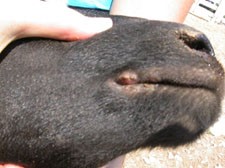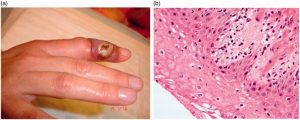Summary
Orf is a highly infectious zoonotic disease caused by a parapoxvirus. The virus is endemic in sheep and goats and can be transmitted to humans through direct contact with infected animals or equipment. The virus causes a blistery lesion on the hands and fingers of humans. Animals with Orf infections may be asymptomatic or have scabby lesions on their lips, muzzle, mouth, lower legs, or teats. Orf infections occur worldwide wherever sheep or goats are present.
Fact Table
| Formal binomial name of microbe: | Poxviridae family
Parapoxvirus genus Orf virus (ORFV) |
| Gram stain: | N/A |
| Mobility: | Immobile |
| Primary habitat: | Skin and mucous membranes |
| Can the organism infect humans? | Yes |
| Can the organism infect other species? | Yes- Sheep and Goats |
| Documented cases of antimicrobial resistance? | No- infection resolves on its own in healthy individuals. Immunocompromised patients require antiviral medications or complete excision of the lesion with skin grafting. |
| Number of infections per year in the US | Unknown |
| Number of infections per year in the world | Unknown |
Description
Orf is a virus infecting sheep, goats, and humans causing crusty lesions on the skin and mucous membranes. Other names for Orf infection include: sore mouth, scabby mouth, or contagious ecthyma. Orf is a highly contagious infection spread by direct contact with infected animals or equipment.
Sheep and goats are commonly infected by Orf virus. Orf virus spreads throughout flocks by contact with infected animals, contaminated feeding troughs or equipment. Lambs or kids may be infected while nursing. Infected animals present with painful blisters or scabbed lesions on the mouth, muzzle, lower legs or teats. Infected animals may also be asymptomatic. The scab material contains virus particles that remain viable in the environment for months. An Orf vaccination is available but only recommended for flocks previously infected with Orf. Preventing Orf in an agricultural setting involves disinfecting buildings, troughs and equipment regularly and quarantining new animals.

Human Orf infection occurs from direct contact with infected animals or equipment. Human to human transmission is rare. Humans infection commonly occurs when broken skin contacts an infected sheep or goat during bottle feeding, shearing, petting or handling equipment. Orf lesions occur on the hands fingers or forearms. The lesions begin as blisters that progress to ulcerated, oozing lesions. In healthy individuals Orf lesions usually heal on their own, without scarring, within three to six weeks. Individuals may experience a mild fever, fatigue or swollen lymph nodes during the infection. Immunocompromised individuals may experience tumor-like lesions and other severe reactions. Immunocompromised patients may require treatment with antiviral medications or complete excision of the lesion with skin grafting. Orf virus is diagnosed by observation of the virus via electron microscopy, histologic evaluation of the scabby lesion or through polymerase chain reaction (PCR) to identify the virus. Humans at risk for Orf infection may wear waterproof gloves when handling sheep and goats, especially when an open sore is present. Additionally, individuals contacting sheep and goats should practice good hand hygiene; washing hands or using an alcohol based hand sanitizer.

Orf virus is a member of the poxviridae family in the genus Parapoxvirus. Parapoxviruses are oval shaped with linear, double-stranded DNA with a unique spiral coat. The Orf virus is enveloped and binds glycosaminoglycans on the host cell’s surface. The virus enters the cytoplasm of the host cell prior to replication. Viruses in the Parapoxvirus genus infect ungulates and humans throughout the world.


News Articles
https://www.umass.edu/newsoffice/article/stoffolano-researches-suspect-virus-vector
Researchers from UMass Amherst visited various farms in Italy to collect adult flies suspected of transmitting the Orf virus between animals. Researchers collected adult house flies to analyze for the presence of Orf virus. The house fly is a suspected vector of the Orf virus.
https://www.fwi.co.uk/livestock/health-welfare/advice-protecting-flock-orf-virus
Orf virus plagues flocks, is difficult to control and the vaccination is not always recommended. Preventing Orf involves vaccinating if the flock has been previously exposed to Orf, thoroughly cleaning lambing sheds and common areas, limiting grazing in pastures previously exposed to Orf and trimming abrasive vegetation from pastures to limit broken skin on uninfected animals.
A child undergoing skin grafts for burns presented with nodular lesions consistent with Orf infection on the burn site. The patient’s family bred cattle and sheep but had no history of Orf or other parapoxvirus infections. The lesions were confirmed to be Orf via PCR. The patient’s skin infection resolved spontaneously after approximately three weeks. The cause of the infection is unknown but could be concurrent or from the skin grafts.
Reference List
“Orf Virus (Sore Mouth Infection)”; Centers for Disease Control and Prevention; https://www.cdc.gov/poxvirus/orf-virus/index.html
“Major Zoonotic Diseases of Sheep and Meat Goats”; National Center for Foreign Animal and Zoonotic Disease Defense; http://iiad.tamu.edu/wp-content/uploads/2012/06/Meat-Goat-and-Sheep-Part-2-English.pdf
“Orf- an orphan disease?”; Journal of the Royal Society of Medicine Open”; https://www.ncbi.nlm.nih.gov/pmc/articles/PMC4527371/
“Parapoxviruses”; Medscape; https://emedicine.medscape.com/article/224833-overview
“Parapoxvirus”; ViralZone; https://viralzone.expasy.org/150?outline=all_by_species